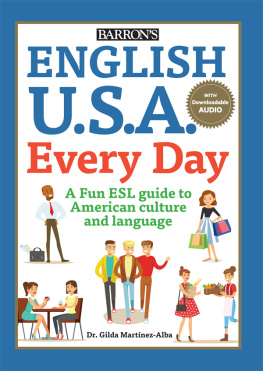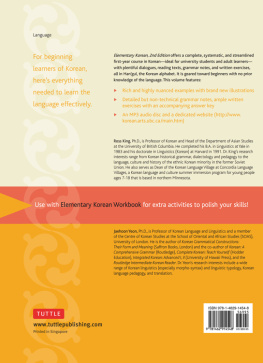Table of Contents
Guide


Acknowledgments I would like to thank Joe and Elaine Czarnecki for
their ongoing support and friendship. PLEASE NOTE: The directions for the various Exercises in this book were written for a printed version of the book; where you are directed to circle or underline words, or write your answers on blank lines in the printed version of the book, please use a separate sheet of paper to list or write out your answers, wherever applicable. FURTHER NOTE: Please note that when you are listening to an audio dialogue, you must stop or finish the current audio dialogue you are listening to before advancing to the next audio dialogue to avoid running the risk of hearing overlapping dialogues. Copyright 2017 Barrons Educational Series, Inc. All rights reserved. No part of this work may be reproduced or distributed in any form or by any means without the written permission of the copyright owner.
All inquiries should be addressed to: Barrons Educational Series, Inc. 250 Wireless Boulevard Hauppauge, NY 11788 www.barronseduc.com eISBN: 978-1-4380-6505-2 Library of Congress Catalog Card No.: 2017028397 Names: Martnez-Alba, Gilda author. Title: English U.S.A. Every Day / by Dr. Gilda Martnez-Alba. | Identifiers: LCCN 2017028397 | ISBN 9781438009704 Subjects: LCSH: English language--Textbooks for foreign speakers. | English language--Grammar--Problems, exercises, etc. | English language--Terms and phrases. | English language--Spoken English--United States. | English language--Spoken English--United States.
Classification: LCC PE1128.M35295 2017 | DDC 428.2/4--dc23 LC record available at https://lccn.loc.gov/2017028397 Table of Contents 



 The Intended Audience and Purpose of This Book Welcome to this journey for intermediate English learners! You will learn new vocabulary and idioms so that by the time you finish this book, you will sound more like a native English speaker and will more easily understand your friends and coworkers. Each chapter will not only help you with vocabulary and idioms but will also teach you interesting topics related to living in the United States. This book can be used by teachers in a classroom setting or by self-learners at home. The answers to the practice exercises are located at the end of the book, so you can check to see if you are correct as you go along. There are also activities in each chapter to reinforce what you have learned. For example, these activities include the following: DIALOGUE STOP AND THINK WRITE IT DOWN MATCHING CROSSWORD IDIOMS STORY TIME
The Intended Audience and Purpose of This Book Welcome to this journey for intermediate English learners! You will learn new vocabulary and idioms so that by the time you finish this book, you will sound more like a native English speaker and will more easily understand your friends and coworkers. Each chapter will not only help you with vocabulary and idioms but will also teach you interesting topics related to living in the United States. This book can be used by teachers in a classroom setting or by self-learners at home. The answers to the practice exercises are located at the end of the book, so you can check to see if you are correct as you go along. There are also activities in each chapter to reinforce what you have learned. For example, these activities include the following: DIALOGUE STOP AND THINK WRITE IT DOWN MATCHING CROSSWORD IDIOMS STORY TIME  This makes it easy to follow along throughout the entire book.
This makes it easy to follow along throughout the entire book.
As each chapter progresses, you will see that the vocabulary and idioms are used more than once to give you time to practice and remember them. There is downloadable audio for you to listen to during the dialogue activities. It might be interesting for you to practice the dialogues with a friendsee if you can say the sentences the way you hear them. It will help you if you use the vocabulary and idioms that you are learning in the book during your everyday interactions as soon as you can. You will get used to using the words, and they will eventually come naturally to you during conversations. After a while, you will not have to think about their meaning because you will remember them from plenty of practice.
Remember: practice makes perfect! Hopefully, you will want to go out and practice what you learn in this book so you can perfect your skills. I hope you have as much fun reading this book and completing the activities as I have had writing it. Now lets get started! 

 After reading this chapter, you should know more about... The U.S. population Dos and donts in American culture American values Vocabulary relating to the United States, such as the following: Society Multiculturalism Norm Culture shock Culture vulture Did you know that there are more than 300,000,000 people living in the United States? See the following example of a conversation or dialogue about the population.
After reading this chapter, you should know more about... The U.S. population Dos and donts in American culture American values Vocabulary relating to the United States, such as the following: Society Multiculturalism Norm Culture shock Culture vulture Did you know that there are more than 300,000,000 people living in the United States? See the following example of a conversation or dialogue about the population.  DIALOGUE 1 Juan: In the United States about 18 percent of the people are Hispanic or Latino .
DIALOGUE 1 Juan: In the United States about 18 percent of the people are Hispanic or Latino .
Sofia: Really? Thats interesting, because it seems like there are more Spanish-speaking people than that. Juan: Maybe thats because we live in an area with a higher percentage? Sofia: Yes, San Diego, California, has a large Hispanic or Latino population. Juan: Ill look it up on my phone to find out. Sofia: Thats a good idea. Juan: On the United States Census Bureau website it says that more than 33 percent of people in San Diego are Hispanics. Sofia: That makes sense.
It seems like everywhere in this society I can hear people speaking in Spanish. Juan: Yes, and there are Latino markets and restaurants everywhere, too. Sofia: What else did you see on that website? Juan: In the United States the majority of the people are white. Then there are 13 percent African American, 6 percent Asian, 1 percent American Indian and Alaska Native, 3 percent are two or more races, and 0.2 percent are Native Hawaiian or Pacific Islander. Hispanics, who can be of any race, make up 18 percent of the population. Identifying as Hispanic is declaring your ethnicity, not your race.
Sofia: Thats interesting. I thought there was more multiculturalism . Hispanic: someone who speaks Spanish and/or has ancestors from Spain. Example: She is Hispanic, but she does not speak too much Spanish. Latino: someone from Latin America (who may or may not have a family history based in Spain). Example: He is a Latino from El Salvador.
United States Census Bureau: an organization that is located in Suitland, Maryland, and collects information about population growth in the United States. Example: The United States Census Bureau sends questions to people around the United States every ten years to find out how the population is changing. society: a group of people in a community or area. Example: We live in a society that allows you to speak your mind. majority: a number or percentage that is more than half of a total. multiculturalism: having more than one group of people with different beliefs and values. multiculturalism: having more than one group of people with different beliefs and values.














 Acknowledgments I would like to thank Joe and Elaine Czarnecki for
Acknowledgments I would like to thank Joe and Elaine Czarnecki for



 The Intended Audience and Purpose of This Book Welcome to this journey for intermediate English learners! You will learn new vocabulary and idioms so that by the time you finish this book, you will sound more like a native English speaker and will more easily understand your friends and coworkers. Each chapter will not only help you with vocabulary and idioms but will also teach you interesting topics related to living in the United States. This book can be used by teachers in a classroom setting or by self-learners at home. The answers to the practice exercises are located at the end of the book, so you can check to see if you are correct as you go along. There are also activities in each chapter to reinforce what you have learned. For example, these activities include the following: DIALOGUE STOP AND THINK WRITE IT DOWN MATCHING CROSSWORD IDIOMS STORY TIME
The Intended Audience and Purpose of This Book Welcome to this journey for intermediate English learners! You will learn new vocabulary and idioms so that by the time you finish this book, you will sound more like a native English speaker and will more easily understand your friends and coworkers. Each chapter will not only help you with vocabulary and idioms but will also teach you interesting topics related to living in the United States. This book can be used by teachers in a classroom setting or by self-learners at home. The answers to the practice exercises are located at the end of the book, so you can check to see if you are correct as you go along. There are also activities in each chapter to reinforce what you have learned. For example, these activities include the following: DIALOGUE STOP AND THINK WRITE IT DOWN MATCHING CROSSWORD IDIOMS STORY TIME  This makes it easy to follow along throughout the entire book.
This makes it easy to follow along throughout the entire book.

 After reading this chapter, you should know more about... The U.S. population Dos and donts in American culture American values Vocabulary relating to the United States, such as the following: Society Multiculturalism Norm Culture shock Culture vulture Did you know that there are more than 300,000,000 people living in the United States? See the following example of a conversation or dialogue about the population.
After reading this chapter, you should know more about... The U.S. population Dos and donts in American culture American values Vocabulary relating to the United States, such as the following: Society Multiculturalism Norm Culture shock Culture vulture Did you know that there are more than 300,000,000 people living in the United States? See the following example of a conversation or dialogue about the population.  DIALOGUE 1 Juan: In the United States about 18 percent of the people are Hispanic or Latino .
DIALOGUE 1 Juan: In the United States about 18 percent of the people are Hispanic or Latino .